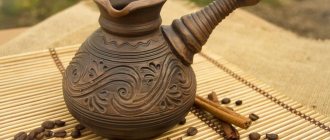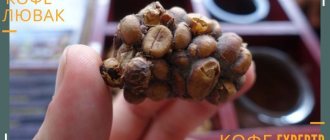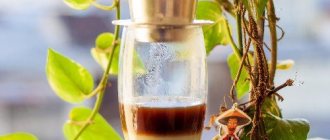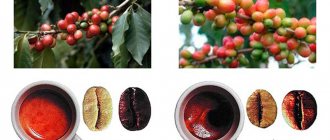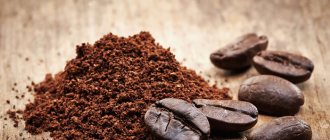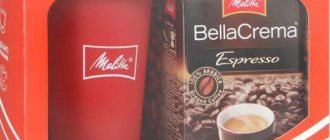Many of us drink one, and some several, cups of coffee a day. This drink energizes you, and sometimes helps you relax and step away from the bustle of the big city. The different effect of the drink depends on what type of coffee tree the drink is made from. If we want to get a charge of vivacity and strength, then the choice should be made in favor of robusta. Let's take a closer look at it.
History of origin of the variety
Robusta is native to Africa. At the beginning of the 18th century, it was found in the central part of the African continent, near the banks of the deepest river in Africa - the Congo. The place where she was found gave her another name. It is often called “Congolese coffee”.
It was only in the 20th century that coffea canephora gained its popularity. This was caused by a disease called leaf rust. It destroyed a large number of Arabica coffee plantations, which had been known throughout the world for several hundred years. As a result, coffee producers turned their attention to robusta, which turned out to be more productive and practically not susceptible to diseases and insect attacks.
History of the Venturim family
Amadeo Venturim began growing Arabica beans in southern Brazil in 1882, immediately after immigrating from Italy. His sons continued his work. In the early 1900s, the family acquired cheaper land in the northern part of the state and also began growing coffee there in 1925. In the 1960s, after the global coffee crisis, Isaac's father cut down the Arabica trees and, like many of his neighbors, began to grow Robusta, which until then was an unknown variety in Brazil.
fazenda Venturim, source @cafefazendaventurim
In 2007, the family decided to produce specialty coffee and began to update their plantings and improve post-harvest processing methods. Since 2012, the farm has been depulping berries on its own. In 2021, Venturim experimented with fermentation for the first time, which opened the doors to the best roasters and coffee shops in the world.
“Robusta berries are much sweeter than Arabica and have a pleasant taste. If Arabica is primarily reminiscent of sweet peas, then Robusta is the powerful sweetness of Turbo chewing gum (the effect is the same) ... "
— Hummingbird Coffee
Where does Robusta grow?
The equatorial areas of the lower slopes of Africa and Asia have become the best places in which Congolese coffee is currently grown. Ideal conditions for growth are:
- Altitude above sea level 200-900 meters;
- High air humidity;
- Air temperature from 10 to 30 degrees (at temperatures below +10 the tree may die).
On coffee plantations, the growth of the coffee tree is limited. To make it easier to harvest coffee fruits, the trees are pruned and formed into a small bush. During the flowering period, the tree is strewn with white and pink flowers, and the coffee plantations become a very picturesque place.
Robusta is harmful. Robusta coffee: characteristics
Robusta coffee is often underestimated when it comes to its bitterness. But it is the beans of this type that give the drink strength and persistent foam, making it possible to highlight the other taste qualities of the coffee mixture. Therefore, lovers of strong espresso with bitterness simply cannot do without Robusta. But many consumers wrinkle their noses in disgust when tasting Robusta. Why? Most likely, they simply did not try selected Robusta.
Robusta is a fortress. It is not recommended to drink the drink in its pure form - you may be disappointed by the bitterness and spiciness of the coffee, and a large amount of caffeine can completely kill the desire to try another cup of espresso.
This variety is usually added to coffee blends. In a 20% ratio with Arabica, Robusta gives the drink a special aroma, making the coffee stronger. The specific taste of Robusta sets off the taste qualities of other varieties, making it possible to enjoy the whole range of aftertaste.
What about cream? No Arabica will produce such foam in a cup. Airy foam, which attracts with its lightness, lasts a long time, giving the drink sophistication. In a duet with caffeine, the refined taste of a cappuccino or latte will not leave anyone indifferent, because Robusta is a boost of energy in the morning and a good recharge throughout the day.
Instant coffee is made from this variety. If this is what you drink, then know that there is not a single Arabica grain in your cup. All coffee that dissolves in water is made from Robusta. When processed, the grains lose their bitterness, making the drink rich and strong.
Most coffee contains a small amount of Robusta. They do this for a reason - Robusta gives the drink strength, light foam and a subtle aroma. No more than 20% beans are added to coffee. The exception is Luwak coffee - one of the most expensive coffees in the world, where Robusta is 50%.
By the way, Vietnamese coffee is made exclusively from Robusta. True, only selected grains of excellent quality are used to prepare the drink. A cup of this coffee is strong and contains a large amount of caffeine.
Especially Robusta coffee reveals its positive features in coffee machines. An experienced bartender will undoubtedly prepare you a delicious Arabica, but he is unlikely to cope with Robusta. Only an automatic machine will reveal the delicious taste and delicate aroma of the grains in the mixture. That’s why I use Robusta in automatic cars in public places. It gives espresso strength and cappuccino a crema top.
Robusta coffee ranks second in popularity. Externally, the grains are round, but their taste is bitter. The price of this type of coffee is much lower than Arabica coffee. The low cost is due to the ease of growing the plant. The tree does not require a special climate, is resistant to temperature changes and is not afraid of diseases. For propagation, it is enough to plant the cuttings in a warm and humid climate, not high above sea level.
Wild trees can reach up to 10 meters in height, but in cultivated conditions they are formed up to 2-3 meters, constantly cutting off the tops. For a generous fruit harvest, there is no need to plant seedlings on mountain plantations - Robusta bears fruit in the lowlands. Mountain ranges are usually occupied by expensive Arabica, which brings in more income.
Unpretentiousness of cultivation and low price are not the only advantages of the species. The variety is often underestimated, saying that it is used to make the drink cheaper. And it’s completely in vain, because Robusta has a number of advantages:
- Strength and high caffeine capacity.
- Long lasting cream.
- Emphasizing the flavors of the drink.
It is Robusta that can reveal the full aftertaste of Arabica. Without strong Robusta, gentle Arabica may not appeal to everyone. If you love strong coffee with bitterness and a wonderful aroma, then you simply cannot do without a few Robusta beans in your cup.
Fans of thick and persistent foam should also remember that their drink also contains Robusta. Therefore, you should not be overly concerned with this variety, giving preference only to Arabica.
Composition and taste
Robusta production accounts for 30% of the world's coffee production. This is due to the fact that robusta coffee has a weak aroma, strong taste and some bitterness. This is explained by the composition of the coffee bean:
- 8% aromatic oils;
- 5% sugars;
- 3% caffeine.
The low content of aromatic oils and sugars does not allow the finished drink to obtain a richer taste and aroma. The high caffeine content makes it more energizing. This drink will please those people who adore strong, bitter coffee.
How is robusta used and what does it add to coffee?
Separate use of coffea canephora is rare. A drink made from 100% Robusta is inferior in taste to coffee made from Arabica. The taste is specific - rough and bitter. The structure of the drink is watery.
For the best price-quality ratio, manufacturers usually make a mixture of Arabica and Robusta. The most common ratio is 80% Arabica and 20% Robusta. Their union turns out to be quite successful:
- The drink acquires a slight bitterness;
- The coffee becomes stronger (compared to 100% Arabica). This is most relevant for making espresso;
- The rich aroma that is present in Arabica beans remains;
- The final cost of the product is reduced (robusta is cheaper).
Coffee blends containing robusta can be found in instant coffee and drinks that we buy from vending machines. In these mixtures its content can be more than 50%. This is done to reduce the final price of the product.
When producing instant coffee, the specific bitterness of the drink is lost. There is a misconception that the lack of bitterness makes a coffee drink less invigorating. For many, the main goal of drinking coffee is to get a boost of vigor and energy for the whole day.
We hope that our article was useful. We introduced you to an interesting coffee variety that has its own advantages and disadvantages.
We recommend reading our articles about Arabica and the differences between Arabica and Robusta to make your final choice. Perhaps this information will help you become a coffee connoisseur in these topics.
Robusta coffee Vietnam. Vietnamese coffee
Coffee from Vietnam is a must-buy during your vacation! Thanks to the mild tropical climate, the grains not only have time to ripen, but also get enough sunlight and moisture. Add to this a specific taste depending on the type of soil, and you will get an incomparable aromatic souvenir.
Vietnamese coffee
Vietnamese coffee is about 150 years old. The trees were brought to the Asian republic by French missionaries in 1857. The first large plantation appeared in Nghe An province, in the north of the country. A few years later, coffee trees began to be grown in the south. Today, Dak Lak province has become the Vietnamese center for coffee production. It is located in the mountains, at an altitude of 1500 m above sea level. In total, more than 3 million people are involved in the production and collection of raw materials. Locals call the drink “liquid gold.” By the way, Vietnam ranks second in the world after Brazil in coffee exports.
Vietnamese coffee varieties
There are two main varieties - Robusta and Arabica. Luwak, Kuli and Escelsa are produced in small quantities. Each of these varieties has a unique taste.
Robusta variety
It is called the “Sun of Vietnam”. They are grown at an altitude of 500-1000 m above sea level. The trees are unpretentious, resistant to temperature changes and pests. The only thing they need is plenty of moisture.
Robusta means “healthy” in English. The beans contain a lot of caffeine and biologically active acids, which means the drink invigorates and gives strength. This coffee from Vietnam has a strong tonic effect. It is consumed in the first half of the day to wake up and get ready for productive work.
Vietnamese Robusta grows mainly in the north of the country. The ideal climate, abundant rain and absence of low temperatures, makes it possible to obtain up to 12 harvests per year from one plantation. The raw materials are not subjected to chemical treatments, which means the grains are completely natural. By the way, the Republic of Vietnam is skeptical about the use of various fertilizers. It is believed that raw materials only need sunlight and moisture, and artificial additives will only spoil them.
Robusta from Vietnam is richly bitter with a distinct earthy or nutty aftertaste. The variety is acid-free.
Arabica variety
Arabica is grown in the center and northwest of Vietnam. Main regions:
- Dalat;
- Shonla;
- Dien Bien;
- Quang Tri.
All these provinces have a humid and warm climate, favorable for growing coffee. Arabica has a soft, balanced taste and a barely noticeable aroma. The variety is not used in its pure form, but is included in the basis of blends.
Variety Luwak
An elite and expensive variety, Luwak, is produced in a unique way. Small animals called musangs live in the republic. Another name is palm marten. The animal feeds on the pulp of the coffee cherry, digests it and defecates. The animal's stomach does not process grains; they leave the body naturally. People wash them and dry them in the sun. The finished drink is free of bitterness and has an interesting rich taste. The specific processing method affects the cost of the product. Luwak is an exquisite and expensive type of coffee.
Variety Kuli
A hybrid of Arabica and Robusta is called Kuli. In Vietnam, it is grown in limited quantities and only in the Dak Lak province. The variety has a beneficial effect on the body:
- activates brain function and mental activity;
- reduces the likelihood of developing diabetes;
- speeds up the functioning of the gastrointestinal tract;
- invigorates, relieves fatigue.
Kuli has a bitter, rich taste, intense aroma and a long aftertaste. Traditionally, it is drunk “diluted” - with milk or ice.
Excelsa variety
Another name is “High Coffee”. Rare premium variety. Trees reach a height of 20 m. They are demanding on the composition of the soil. The harvest literally depends on chance. It is impossible to predict whether there will be fruiting this year or not. The fruits are shaped like Arabica - fragrant and large. Excelsa has a rich, bright taste. It is not consumed as a separate product, but is added to elite coffee blends to obtain an additional aftertaste.
What coffee to bring with you from Vietnam
Vietnamese coffee has a whole bouquet of flavors. These are the shades:
- hot chocolate;
- vanilla;
- milk;
- caramel;
- cocoa.
Traditional types of coffee are mixed together to make blends. As a result, new varieties are obtained. It’s difficult to say which coffee is the best in Vietnam. It all depends on your preferences.
Tourists bring Robusta home because of its affordable price. But the tart, earthy taste isn't to everyone's taste. Those who like a soft, less rich drink buy Arabica. In Vietnam, these two varieties are often mixed in a combination of 70% Robusta and 30% Arabica. This is the best value bean coffee.
The exotic Luwak is also popular. If you are not embarrassed by the method of its production and the high cost, it will be a wonderful and useful gift.
By the way, in Vietnam it is customary to roast grains heavily, which gives the finished drink a bitter taste.


